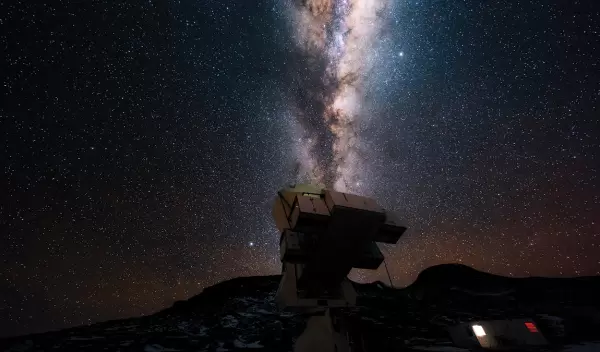
Detecting faint traces of universe's explosive birth is aim of NSF-supported Advanced Simons Observatory
A remote, high-altitude astronomy observatory will conduct the most detailed investigation yet of the universe's origins, with upgrades provided by a $52.7 million investment from the U.S. National Science Foundation. In partnership with the Simons Foundation, the NSF grant will expand the Simons Observatory in the high Atacama Desert of Chile to become the Advanced Simons Observatory. NSF's grant will be administered by the University of Pennsylvania and will fund 30,000 additional radio frequency detectors, a new data pipeline and a sustainable, solar energy-based electrical system.
The Advanced Simons Observatory builds on a collaboration supported by the Simons Foundation, the Heising-Simons Foundation and participating institutions. The project broke ground in Chile in 2019. A particular focus for the observatory is the cosmic microwave background radiation that permeates the universe and contains hidden clues about how the early universe evolved into what it is now. The enhanced observatory will be used to probe scientific mysteries — including dark energy and dark matter — by analyzing previously undetectable traces of the background radiation created billions of years ago during the Big Bang. The new detectors will double the observatory's imaging speed and significantly increase its sensitivity, while the accompanying data processing and storage system will enable broader access to a trove of astronomical data for analysis by the scientific community.
"Research infrastructure is the essential workhorse behind America's global leadership in science and engineering," says NSF Director Sethuraman Panchanathan. "NSF's partnership with the Simons Foundation on the Advanced Simons Observatory demonstrates how public and private organizations can effectively join forces to create innovative research infrastructure needed for tomorrow's breakthrough discoveries, while simultaneously strengthening our scientific workforce."
"This important award from NSF helps the Advanced Simons Observatory achieve an entirely new level of efficiency and economy," says David Spergel, president of the Simons Foundation. "Adding public support to an ambitious, privately funded project is a terrific example of what can happen when two missions can dovetail — to everyone's advantage."
At more than 17,000 feet above sea level in Chile's Atacama Desert, the observatory's remote location provides some of the world's best viewing conditions in the thin, bone-dry air. It's also far from the local power grid. The observatory currently relies on diesel generators supplied by fuel trucks that regularly make the long journey up the rough mountain road. The new NSF-supported solar energy system will provide 70% of the observatory's power, reducing the observatory's diesel consumption by over 400 gallons a day and saving about $1 million annually.
NSF's grant also provides funding for the training of early-career researchers and students through mentorship opportunities with senior researchers at the observatory. In partnership with the National Society of Black Physicists, Chilean institutions and other organizations, the observatory will help to expand access to research opportunities for many groups.
Advancing scientific understanding of cosmic microwave background radiation was identified as a key priority in the 2020 Decadal Survey on Astronomy and Astrophysics. The Advanced Simons Observatory is a substantial step toward that goal and is part of NSF's long-term support for increasingly capable investigations of cosmic microwave background radiation, including investments in facilities at Cerro Toco by NSF and other partners over the last 20 years. The enhanced observatory will help further the "stage 4" cosmic microwave background experiment recommended by the decadal survey, which requires facilities in Chile and at NSF's Amundsen-Scott South Pole Station.
The Advanced Simons Observatory is supported through NSF's Mid-scale Research Infrastructure-2 program, which funds equipment and other infrastructure projects needed by the U.S. scientific community that cost between $20 million and $100 million. Announced in March, the Compact X-ray Free-Electron Laser facility is supported by the same program.
